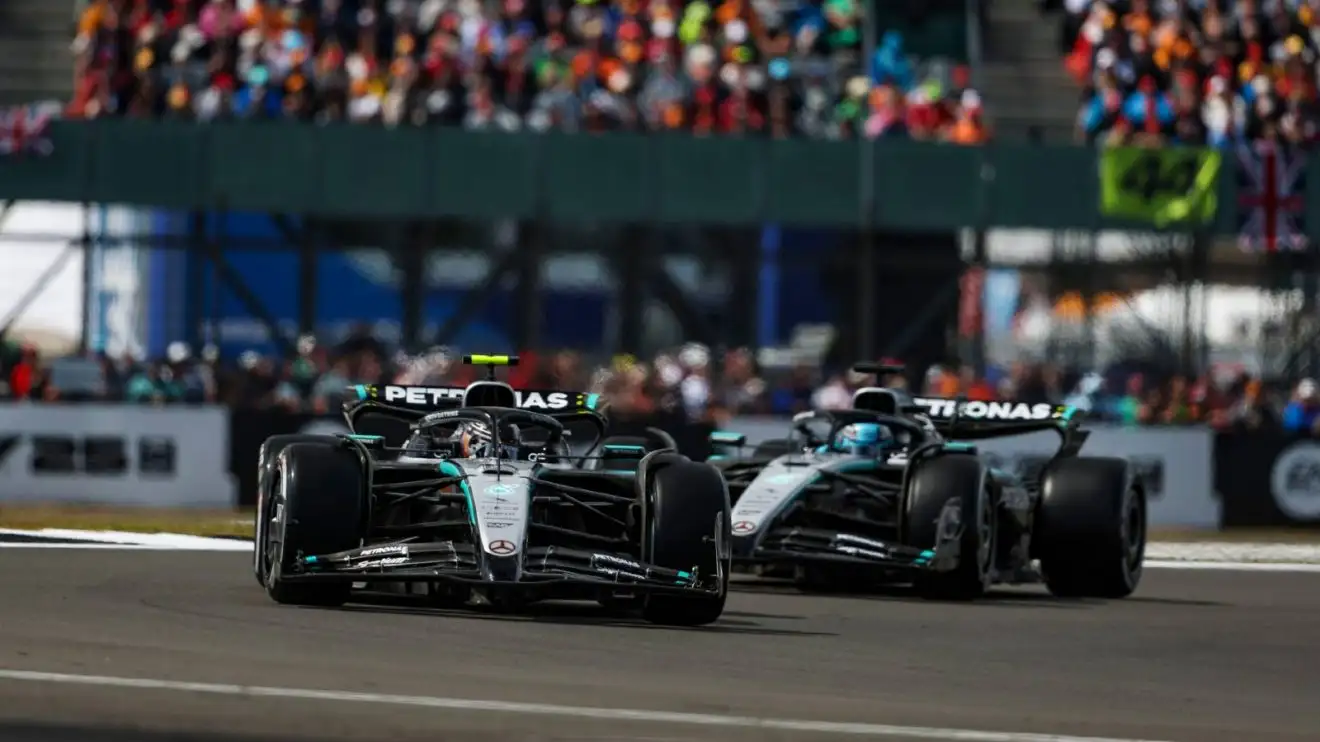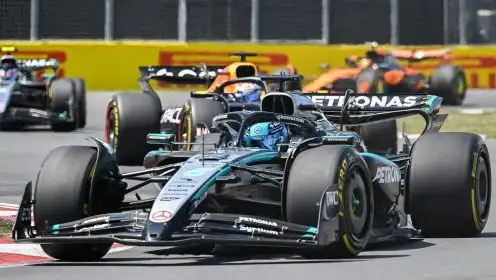Mercedes’ F1 2026 power unit advantage area identified as main challenge revealed

The two Mercedes drivers on track at the 2025 British Grand Prix.
Paddock whispers and speculation suggest Mercedes will have the power unit to beat in F1 2026, and one advantage for the manufacturer has already been identified.
F1 2026 sees Formula 1 introduce very different power unit regulations, with a ratio split of 50/50 between power from the internal combustion engine and the electrical hybrid ancillaries – a significant increase in electrical power output from the current hybrid power units.
Where Mercedes does have an advantage for F1 2026
After a few years of stability on the power unit front after the introduction of an engine freeze at the end of 2021, all eyes are on the manufacturers to see which of them can come out of the blocks with the best power unit for the new regulations.
There are more names in the mix: Not only does Red Bull enter the arena as an engine manufacturer with its new Red Bull Powertrains (RBPT) project, but Audi enters F1 with its own offering as the German marque has entered as a factory effort.
With Renault exiting as an engine manufacturer, Honda formally returns as a full works effort again following its semi-withdrawal after 2021, while Mercedes and Ferrari continue as usual.
The last significant power unit rules change was in 2014, where Mercedes’ High-Performance Powertrains nailed the switch from the normally aspirated V8 to the 1.6-litre hybrid V6 turbo to dominate the sport for several seasons.
If rumours are to be believed, Mercedes may yet just repeat that feat of engineering ingenuity for 2026, as rival manufacturers and paddock whispers have earmarked the new power unit out of Brixworth as being the one to watch.
While the 1.6-litre V6 architecture remains, the MGU-H, the motor generator unit that recovered energy from exhaust gases, has been removed in the name of cost reduction and simplification.
The MGU-K output increases from 120kW to 350kW, with the power units’ total output of around 1,000bhp seeing the split change from the internal combustion engine providing around 80 per cent of the power to a figure of roughly 50 per cent.
The electrification push will represent some major engineering challenges for all of the manufacturers, although all are remaining tight-lipped about just how good their new offerings may be by the time the new cars roll out on track in early 2026.
But while Mercedes’ advantage in terms of the finished product isn’t yet confirmed, the manufacturer does have one major advantage over the competition in that, due to it supplying engines to four teams in total, the amount of data that can be gathered will accelerate its learning compared to immediate rivals.
Mercedes not only supplies the factory team, but reigning Constructors’ Champions McLaren, as well as Williams and, from 2026, Alpine.
Ferrari is the next most common engine, supplying its own team as well as customers Haas and the incoming Cadillac team.
Audi will only have the data from its own team to learn from, while RBPT will have its two teams in Red Bull Racing and Racing Bulls, and Honda will only have data from Aston Martin.
“I think supplying multiple teams as a power unit manufacturer, the reason you do it is because it gives you exactly that [an advantage], particularly on reliability and proving our technology,” Mercedes’ chief communications officer and team representative Bradley Lord told select media, including PlanetF1.com, ahead of the F1 summer break.
“There’s an advantage to that. It also comes at a… cost is the wrong word, but it brings with it the challenge of needing to have more parts ready, more power units ready, more products ready sooner, in order to enable those four teams to go testing and go racing and things like that.
“So it’s not without challenge, but one of the upsides is certainly that you get more extensive prove-out mileage, and you’re learning at a faster rate thanks to the mileage that all eight power units will be doing at the first race weekend.
“That will certainly be positive. Equally, if you find challenges, you have eight sets of solutions that you need to deliver, not just two or four or six.
“So there are sort of upsides and downsides to it, but we believe that the upside of that learning outweighs the downsides.”
More on Bradley Lord and Mercedes
👉 Who is Bradley Lord? Meet Toto Wolff’s trusted Mercedes lieutenant
👉 ‘We’ll go through fire’ – Inside Mercedes’ team culture with Toto Wolff’s ‘left-hand man’
The possibility is distinct that, should one manufacturer have a major advantage at the start of the new regulations cycle, this momentum could take some time for the other manufacturers to close in to reduce a performance differentiator that hasn’t been a factor for several years.
There have been discussions at the F1 Commission level to introduce mechanisms to ensure that those who don’t hit the ground running will have opportunities to close the gap, and Lord said he has no doubt that the new regulations will deliver, despite the murmurings of naysayers in recent months.
“If we look back at the initial stages of 2014, there was a lot of comment and a lot of outcry about disparities in performance, lack of reliability, lack of noise, the racing being compromised, and we have seen during this era of Formula 1, some of the most epic seasons that there have been in the history of the sport,” Lord said.
“If we think back to a season like 2021, as performance deltas have closed between teams over time, the sport has tried to create rules that avoid those significant deltas in performance at the start of a new rule set.
“But it’s normal that, when rules change, human beings in general are resistant to change and tend to focus as much on what they’ve lost as what has been gained.
“So we are in a phase now where the rules are still being fine-tuned and tweaked and are evolving in order to make sure that the racing spectacle that we deliver in 2026 is… it will be different, but to make sure it’s entertaining, compelling, and not a backward step in any way from what we have today.
“The drivers are in the phase of starting to understand, and we’re seeing internally, every single week, progress and fine-tuning, and differentiation.”
Lord pointed to how Mercedes’ reserve Valtteri Bottas, who has driven the F1 2026 car in the simulator, revealed that, in his opinion, the regulations might produce a driving experience that isn’t vastly different from now.
“He said that, by the time we get to the start of next season, actually, it won’t be the same as it has been this year, but we’ll be in a situation where it will be something that feels very familiar,” he said.
“The focus is on how to extract more performance. How can we overtake here? How can we optimise lap time rather than anything else?
“So I think we will all be going on a journey as stakeholders in and fans of Formula 1, to understand the racing and to explain that to the fans as well, what’s changing and why it’s changing.
“But Melbourne 2026, it will be Formula 1 as we know it, and when the lights go out, it will be racing as we know it, and we will see people fighting tooth and nail to win the grand prix.”
Read Next: Lewis Hamilton releases new statement ahead of Dutch Grand Prix





